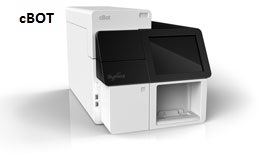BioMicroCenter:Illumina Sequencing
| HOME -- | SEQUENCING -- | LIBRARY PREP -- | HIGH-THROUGHPUT -- | COMPUTING -- | OTHER TECHNOLOGY |
The MIT BioMicro Center has six high-throughput Illumina sequencers including one NovaSeq 6000, one HiSeq 2000, two NextSeq 500s and two MiSeqs. We support a wide variety of applications, such as ChIP-Seq, miRNA sequencing and RNA-seq. Each lane has the potential to accommodate dozens of barcoded samples (depending on sequence complexity and desired coverage). Read lengths vary, depending on users, between 20nt and 325nt per end.
Illumina Massively Parallel Sequencing
|
Illumina sequencing-by-synthesis is the primary workhorse of the BioMicro Center. These instruments produce millions of reads simultaneously and are used in a very broad spectrum of applications. The Center currently supports 1 NovaSeq 6000, 1 HiSeq2000, 2 NextSeq500s, and 2 MiSeqs. In addition, we have access to additional sequencing instrumentation through a long standing collaboration with the Whitehead Genome Technologies Core. Typical WorkflowIllumina sequencing at the core begins with library quality control, during which the Center verifies the anchor elements and insert size using qPCR and the Fragment Analyzer. Users may elect to bypass this step if they provide the sample concentration and the concentration they would like to load at. Samples are then entered into the sequencing queue. Typical queues in the BioMicro Center are short, rarely exceeding 1-2 weeks, and samples are frequently run within a couple days. We do guarantee a minimum number of reads per lane provided if: a) BMC performed the QC, b) the samples are high-complexity, especially in the first few nucleotides, and c) the samples are at least 2nM. Illumina sequencing through the BioMicro Center is only available in full lanes and not on a per read basis. You are welcome to collaborate with other laboratories in order to share a lane. However, please be sure to minimize any possibility of cross-contamination of indexes as well as index crosstalk. Data HandlingFollowing sequencing, data is handled using a custom analytical pipeline. If an index was provided, samples are split by index and identified by DNA-ID. FASTQ files and other desired formats will be placed in a delivery folder based on the project name, along with several quality control checks done for the sequencing data. We will provide an initial review of your project where we do try to identify any issues including incorrect indexes, sample contaminants, etc. Please note that our pipelines are built to find problems and are NOT designed to provide an initial analysis of your data. These analyses are built for speed, simplicity, and are not tuned in any way for your samples. We are always happy to discuss these with you. Data will be available in your lab folder for 90 days post delivery, after which most of the data is deleted. FASTQ file will still be downloadable for two years but is delivered on a case by case basis. Custom SequencingUsers may elect to prep their samples with custom oligos. If this is the case, custom sequencing oligos must be provided along with the samples at the time of submission. At least 15uL of each kind custom sequencing primer at 100 uM should be submitted per lane of HiSeq, MiSeq, or NextSeq. At least 30uL of each kind of custom sequencing primer at 100uM should be provided per NovaSeq flowcell. It is strongly recommended to contact biomicro@mit.edu before planning a custom library preparation.
|
 Additional services available: |
Illumina Platforms
| SPEC | HiSeq2000 | MiSeq | NextSeq500 | NovaSeq6000 |
|---|---|---|---|---|
| SEQUENCER |  |
 |
 |
 |
| READS/LANE Low number is minimum per lane for standard Illumina libraries. |
|
|
|
|
| NT/DAY |
|
|
|
|
| LENGTHS AVAILABLE |
|
|
|
|
| USES |
|
|
|
|
| KEY NOTES |
|
|
|
|
| DONATED BY | Drs. Penny Chisholm and Chris Burge and HHMI | Drs. Chris Love, Michael Birnbaum and the Dept. of Biological Engineering. | Drs. Penny Chisholm, Doug Lauffenburger, Myriam Heiman, Li-Huei Tsai and the Dept. of Biology and the Koch Institute. | Drs. Manolis Kellis, Li-Huei Tsai and MIT, The MIT Stem Cell Initiative and the Dept. of Biology and the Koch Institute. |
